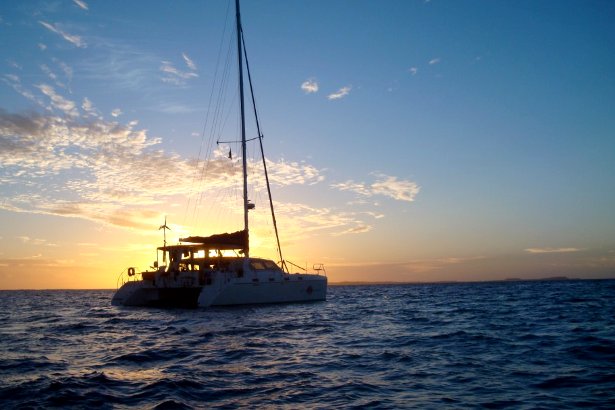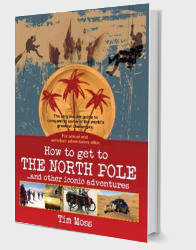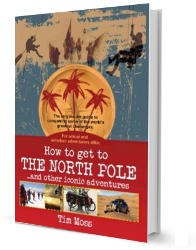
THIS ARTICLE: Explains how you can take a boat and explore the world’s oceans. There is a brief history of sailing followed by an explanation of the options available including sailing with a company, on a tall ship, as a crew member, in a round-the-world race or rally, and cruising independently. The likely difficulties are detailed, information on boat choice is given and there is a breakdown of the costs. Finally, first steps are spelled out to get you from marina to ocean.
Background
Seafaring goes back a long way. Canoes and paddles may have been the start but records show sails in use in the Arab empires hundreds of years BC, if not thousands. In the first millennium, the Polynesian’s ferried people between islands with sailboats, the North Europeans combined singular square sails with oars, the Chinese used multiple masts on junk ships, and the Indians and Arabs explored the Indian Ocean with triangular sailed dhows.
The invention of the compass in the second millennium meant sailing grew significantly and Western Europeans dominated in trade, exploration and colonisation. Come the 17th century and sailing became a pastime for the richer members of society. Modern technologies such as satellite communications and GPS navigation may have made many aspects of sailing easier and more attainable but, when you’re out at sea in a tiny sailing boat, not a lot has changed.
The likes of Joshua Slocum, Robin Know-Johnston, Bernard Moitessier and Ellen MacArthur may have pushed the boundaries of round-the-world sailing but for every one sailor like them, there are a thousand others who join sociable rallies across the Atlantic, holiday in the Mediterranean or embrace the nomadic live-aboard life.
(For an explanation of the term, see my article What are the Seven Seas?)
[divide]
[box type=”note” bg=”#ebebeb” color=”#111″ font=”arial” fontsize=”13″ border=”#a6a6a6″ head=”How To Sail the Seven Seas” headbg=”#21417b” headcolor=”#fff”]
This is an edited excerpt from the How To Row An Ocean chapter of my new book: How To Get To The North Pole And Other Iconic Adventures.
The book features a foreword by Sir Ranulph Fiennes, an endorsement from Bear Grylls and contributions from over 50 legendary explorers from Mark Beaumont to Sir Chris Bonington.
[button color=”green” link=”http://thenextchallenge.org/books” size=”big” font=”arial” fontw=”bold” textcolor=”#fff” texthcolor=”#d00000″ align=”center” radius=”8″]Order Now[/button]
[/box]
[divide]
Options
With a company
You can pay to go on a big sailing trip where an experienced captain will show you what you need to do. An easy way to start and learn the ropes. A week’s sailing might cost £500-£1,500. An Atlantic crossing £1,500 upwards.
On a tall ship
Tall ships are big, traditional sail boats like the Cutty Sark. They require big crews and are used for training people and for fun races. A day might cost £100, a trans-Atlantic voyage £1,500 through one of the following:
As a crew member
Boats always need sailing from one place to another and often don’t have enough crew. Opportunities are available even for the inexperienced. You usually just pay your own expenses and a kitty contribution. As well as hanging out at busy marinas, there are specific websites:
In a rally
Sailing rallies are technically races but the focus is more on enjoyment than anything competitive. They are a great way to try a long journey but with the safety of numbers. Some examples include:
Clipper Round-the-World Yacht Race
This is a well-known race around the world in which a trained skipper leads a crew of amateurs. You get full training and can sign up for individual stages (from £8,000) or for the whole trip (£40,000). Visit the Clipper website for details.
Independent cruising
Buying your own boat is a big investment but cruising independently is surely the purest way to enjoy the Seven Seas. Because the other options are easier and more structured, the majority of this article focuses on the independent cruising option.
When To Go
Most cruisers will do their cruising outside of storm seasons, the times of year when tropical cyclones are most likely. This is a rough guide to storm seasons around the world:
- North Atlantic Ocean: 1 June – 30 November hurricane season
- South Atlantic Ocean: cyclones are rare
- Eastern Pacific Ocean: 1 June – 30 November hurricane season
- Central Pacific Ocean: 1 June – 30 November hurricane season
- Western Pacific Ocean: Typhoons common all year, particularly June-November
- North Indian Ocean: April – December approximate cyclone season
- South Indian Ocean: November – April approximate cyclone season
Difficulties
Sea sickness
Sea sickness is hard to predict. Losing water and not taking in food can be quite debilitating. Treatments include:
- Staying in the middle of the boat (as it rocks less)
- Fixing your eyes on the horizon
- Taking ginger supplements
- Wearing a pressure-point wrist band
- Taking antiemetics (over the counter or prescription)
Storms
The danger of a storm is that winds and/or waves knock you over sideways, you surf too fast down a wave a pitch-pole (cartwheel) or the wind and waves damage your boat.
Travelling outside of storm season, monitoring forecasts and researching local conditions will all help you avoid problems. If you get caught then dropping your sails significantly reduces the risk. You can then go with the flow rather than fighting it and take actions to slow yourself down.
For more detail, see my article What Actually Happens When a Boat Gets Caught in a Storm?
Calms
More common than getting caught in a storm is suffering from a lack of wind. Taking over controls from self-steering and auto-pilot may be necessary but sometimes you’ll just have to sit it out.
Collisions
You may think that the chances of hitting something else in such a vast ocean are tiny but most people tend to follow the same prevailing trade wind routes at the same times of year. Maintaining 24-hour watch and/or monitoring your radar are the most common solutions.
Pirates
Even in the 21st century, pirates are still a risk in certain areas of the world. Use Noonsite for the latest piracy reports.
Choosing a Yacht
Catamaran vs Mono-Hull
“Cats” have two separate parallel hulls connected by a bridge in the middle. Monohulls are the more typical, single-hulled boats.
- Catamarans are usually faster
- They don’t rock from side to side (meaning less sea sickness)
- They are harder to capsize (but won’t self-right when they do, unlike a good mono hull)
- They tend to be more expensive and their size means not all marinas can accommodate them.
Hull materials
- Fibreglass: Tough, enduring and easy to repair. Often called GRP: glass-reinforced plastic.
- Metal: Strongest material but heavy, particularly for small boats. Steel is the most common but rusts. Aluminium is doesn’t and it’s lighter but also rarer.
- Wood: Cheap to start but expensive and time-consuming to maintain.
Boat size
Boats are measured by their length. For a fairly routine ocean crossing with two or three people between 9 and 14 metres would be typical.
Costs
Some rough guideline costs are:
- New boat: £45,000-£500,000+. More flexibility and a guarantee but at a premium.
- Second-hand boat: £20,000-£300,000+.
- Extra equipment: £5,000-£30,000.
- Cruising costs: £500-£1,200 for supplies, mooring fees, country visiting fees, communications, repairs and maintenance.
Lowest total cost: £50,000 (£25,000 each). A cheap second-hand bargain you repair yourself, splitting costs with a crew mate, living frugally for six months and anchoring off-shore.
More typical total cost: £120,000 (£60,000 each). Still buying second hand but selecting the equipment you want, paying for repairs and doing a slow, one-year loop of the world.
First Steps
- Sign up for a course or otherwise find your way onto a boat to get a feel for sailing.
- Build your on-deck experience by joining a club, volunteering as crew or going on a tall ship.
- The next step is the big one: buy a boat. You can learn about equipment and repairs as you go.
- Start with day trips in sheltered areas, perhaps going out overnight.
- Cross the Channel to France or head down to Spain and back.
- Join a rally and cross an ocean with company.
- Try the return journey on your own or with a small group.
- Now go for a popular trade wind route on your own. After this, you can carry on wherever the winds take you.
Further Reading
If you are considering a big sailing trip then my book – How to Get to the North Pole and Other Iconic Adventures – has a whole chapter devoted to the topic of ‘How to Sail the Seven Seas’, as well as chapters for six other adventures.
The following excerpts are available to read online for free: The Youngest Person to Sail Solo Around the World, What are the Seven Seas? and What Actually Happens When a Boat Gets Caught in a Storm?
[divide]
How to Get to the North Pole:
and Other Iconic Adventures
Includes the chapter ‘How to Sail the Seven Seas’
6 more chapters. 10 times the detail.
- Top 10 Best Seller on Amazon’s Discory & Exploration
- “Highly recommended” – Adventure Travel Magazine
- Foreword by Sir Ranulph Fiennes
- Endorsed by Bear Grylls
- 100% five-star reader rating
[button color=”green” link=”http://www.thenextchallenge.org/books/” size=”big” font=”arial” fontw=”bold” textcolor=”#fff” align=”center” radius=”10″]Read More[/button]


What do you think? Please do add your thoughts below…